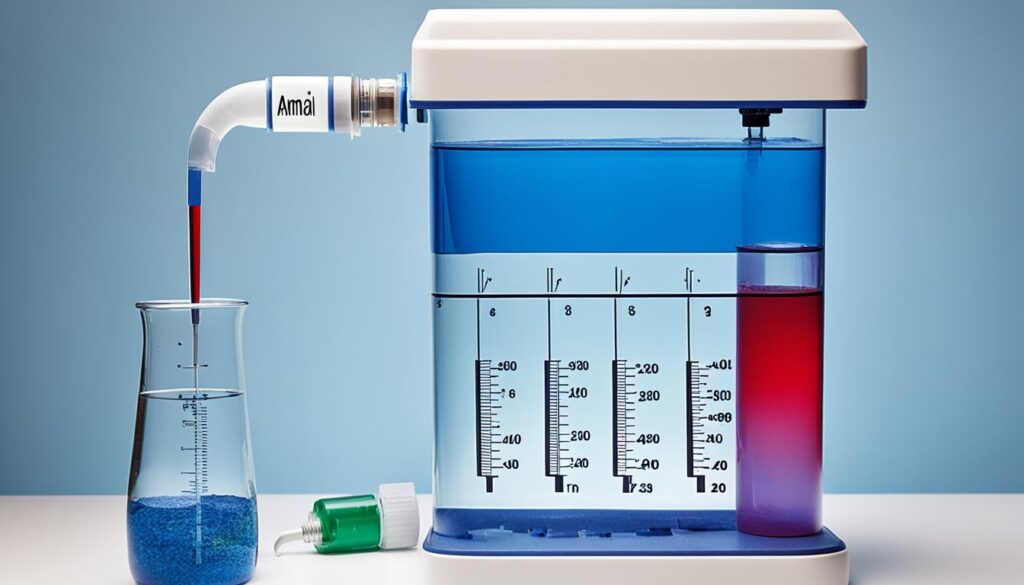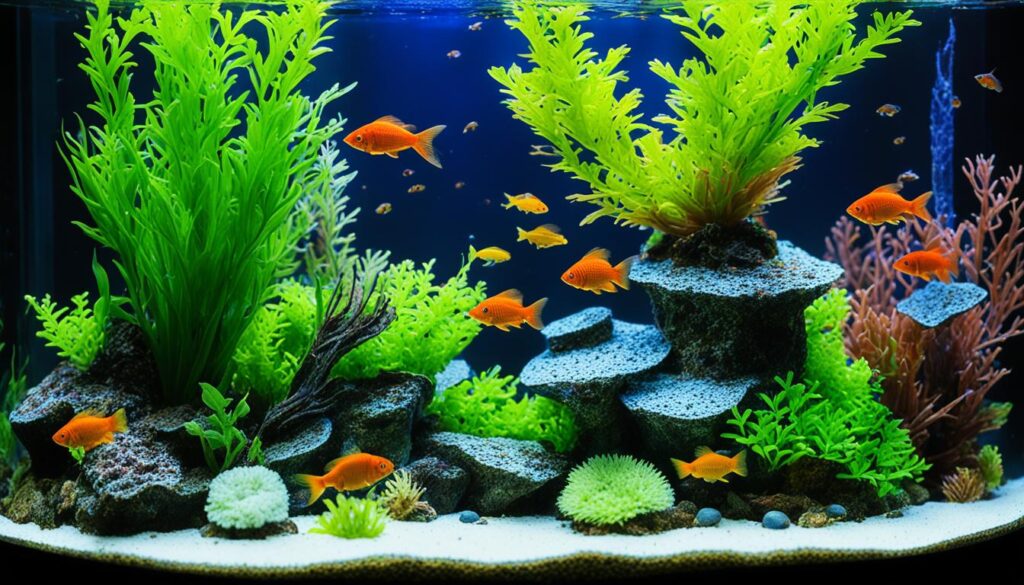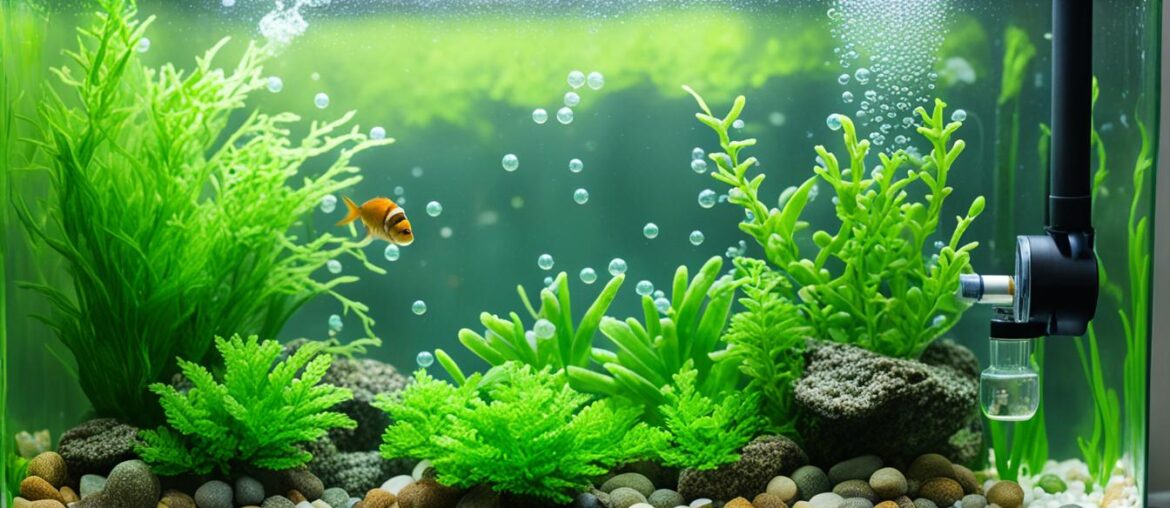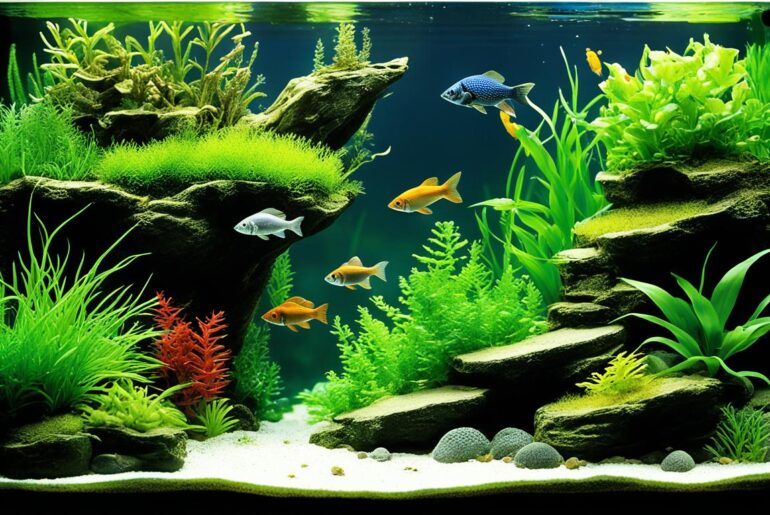Have you ever experienced the excitement of setting up a new fish tank? The anticipation as you carefully select the perfect tank, colorful decorations, and vibrant aquatic plants fills your heart with joy. And then, the time comes to introduce your new fish to their home. But before you can fully enjoy the beauty of your underwater oasis, there’s a crucial step that cannot be overlooked – cycling the tank.
Cycling a fish tank is like laying the foundation for a sturdy house. It’s the process of creating a healthy environment for your finned friends, ensuring their well-being and happiness. I remember the first time I set up a tank without properly cycling it. The fish I brought home seemed energetic and vibrant at first, but as days went by, they grew lethargic, lost their appetite, and sadly, some did not survive. It was a heartbreaking lesson to learn.
But don’t let my mistake discourage you. I’m sharing this personal experience because I want you to avoid the same pitfalls. By following the best cycling method for new tanks, you can create a safe haven for your fish, allowing them to thrive and bring joy to your life.
Key Takeaways:
- Cycling a fish tank is crucial for creating a healthy environment for your fish.
- Proper tank cycling establishes a balanced nitrogen cycle, ensuring the well-being of your aquatic pets.
- Learn from my experience and avoid introducing fish to an uncycled tank.
- By following the step-by-step guide, you can ensure a successful and fast cycling process.
- Choose the best cycling method that suits your needs, whether it’s fish-in cycling or fishless cycling.
What is Cycling a Fish Tank?
Cycling a fish tank is a crucial process for establishing a stable and healthy environment for your aquarium inhabitants. It involves the growth of beneficial bacteria in the tank that play a vital role in converting toxic substances into less harmful compounds. By cycling the tank, we create a balanced nitrogen cycle that ensures the safety and well-being of our aquatic pets.
The nitrogen cycle in a fish tank consists of three essential stages: ammonia production, conversion of ammonia to nitrite, and conversion of nitrite to nitrate. Each stage is facilitated by specific types of bacteria. Understanding this process is essential for maintaining a thriving aquarium environment.
During the cycling process, fish waste and excess food in the tank produce ammonia. This ammonia, if left unchecked, can harm fish and other aquatic organisms. However, beneficial bacteria known as nitrosomonas bacteria convert this toxic ammonia into nitrite, which is still harmful to fish.
In the final stage of the nitrogen cycle, another group of bacteria called nitrobacter bacteria convert nitrite into nitrate, which is relatively less harmful to fish. Nitrate is then removed from the tank through regular water changes and the use of specialized filtration systems.
This entire tank cycling process is vital because high levels of ammonia and nitrite can be deadly to fish and other aquatic organisms. By establishing a healthy nitrogen cycle, we create a safe and comfortable habitat for our fish, promoting their overall well-being.
To better understand the nitrogen cycle and its significance, let’s take a closer look at each stage:
- Ammonia production: Fish waste and excess food decompose, producing ammonia.
- Conversion of ammonia to nitrite: Nitrosomonas bacteria convert ammonia into nitrite, which is still harmful to fish.
- Conversion of nitrite to nitrate: Nitrobacter bacteria convert nitrite into nitrate, which is relatively less harmful.
Having a thorough understanding of the tank cycling process and the importance of maintaining a healthy nitrogen cycle is crucial for any fish tank owner.
The Nitrogen Cycle: Three Stages
The nitrogen cycle in a fish tank plays a crucial role in maintaining a healthy and stable aquatic environment. It consists of three key stages: ammonia production, conversion of ammonia to nitrite, and conversion of nitrite to nitrate.
The first stage of the nitrogen cycle involves the production of ammonia. This occurs through the decomposition of fish waste, excess food, and other organic matter in the tank. Ammonia is highly toxic to fish and can be harmful to their health and well-being.
In the second stage, a group of bacteria called nitrosomonas comes into play. These bacteria convert ammonia into nitrite through a process called nitrification. While nitrite is less toxic than ammonia, it can still be harmful to fish if present in high concentrations.
The final stage of the nitrogen cycle involves another group of bacteria called nitrospira, which convert nitrite into nitrate. Nitrate is the least toxic form of nitrogen and is relatively harmless to fish in low to moderate concentrations.
Having a healthy population of these beneficial bacteria, including nitrosomonas and nitrospira, is essential for maintaining water quality and a balanced nitrogen cycle in your fish tank. These bacteria help convert toxic compounds into less harmful substances, ensuring a safe environment for your aquatic pets.
The diagram above provides an illustration of the nitrogen cycle in a fish tank, depicting the conversion of ammonia to nitrite and nitrite to nitrate by the respective bacteria. Understanding and monitoring the nitrogen cycle is vital for keeping your fish tank in optimal condition.
Step-by-Step Guide to Cycling a Fish Tank
When it comes to cycling a fish tank, a systematic approach is key to creating a healthy and thriving environment for your aquatic pets. Follow this step-by-step guide to ensure a successful tank cycling process.
Tank Setup
Start by setting up your fish tank with the necessary equipment. This includes installing a high-quality filter, heater (if required), and adequate lighting. Ensure the tank is properly cleaned and free from any contaminants before proceeding.
Dechlorination
Before adding water to the tank, it’s important to dechlorinate it. Chlorine in tap water can harm the beneficial bacteria needed for the cycling process. Use a water conditioner specifically designed to neutralize chlorine and chloramine.
Filter Starter
Introduce a filter starter product or live bacteria culture to kickstart the growth of beneficial bacteria in your tank. These products contain strains of bacteria that aid in the conversion of harmful substances during the cycling process.
Introducing Livestock
During the cycling process, it’s essential to limit the introduction of livestock to avoid stressing them or overwhelming the tank’s ecosystem. It’s recommended to add some hardy and low-maintenance fish, such as danios or mollies, at this stage.
Limiting Ammonia Production
To ensure the well-being of your fish, limit ammonia production during the cycling process. Feed them sparingly and avoid overstocking the tank. Excess food and waste can lead to high ammonia levels, which can be harmful to the fish.
Reducing Pollutant Levels
Regularly check the tank for uneaten food, decaying plants, and other sources of pollutants. Remove any debris promptly to maintain water quality and prevent a buildup of toxins that can hinder the cycling process.
Monitoring Cycle Progress
Keep a close eye on the progress of the nitrogen cycle by regularly testing the water parameters. Use a reliable water test kit to measure ammonia, nitrite, and nitrate levels. This will help you track the cycling process and make any necessary adjustments.
Water Test Kits
Investing in a water test kit is crucial for monitoring and maintaining the water quality throughout the cycling process. It allows you to accurately measure the levels of ammonia, nitrite, nitrate, and other parameters that affect the health of your fish.
Following these steps will ensure a successful cycle for your fish tank, establishing a stable and thriving environment for your aquatic pets.
Testing Ammonia, Nitrite, and Nitrate Levels
To ensure the success of your fish tank cycling, it’s essential to regularly test the levels of ammonia, nitrite, and nitrate in the water. Monitoring these levels will help you maintain a safe and healthy environment for your fish and other aquatic organisms.
There are different options available for testing the water quality in your tank. You can choose individual test kits specifically designed for measuring ammonia, nitrite, and nitrate concentrations. These kits allow you to accurately assess the levels of each chemical.
Alternatively, you can opt for a manual test kit set that includes tests for ammonia, nitrite, and nitrate, along with other water parameter tests. This comprehensive approach provides a complete picture of the water quality, allowing you to monitor other essential parameters simultaneously.
Regular testing is important because excessive levels of ammonia and nitrite can be harmful to your fish, causing stress and health issues. Elevated nitrate levels are also a cause for concern, as they can indicate poor water quality and the need for maintenance or adjustments to your tank’s filtration system.
By routinely using test kits to monitor ammonia, nitrite, and nitrate levels, you can take prompt action to address any imbalances and ensure the optimal health and well-being of your aquatic pets.
Fishless Tank Cycling Method
When it comes to establishing a healthy nitrogen cycle in a new aquarium, the fishless tank cycling method is a preferred choice for many aquarists. This method eliminates the risks associated with introducing fish to an uncycled tank, ensuring their safety and well-being. By following a few key steps, you can successfully cycle your tank without the need for live fish.
To initiate the fishless tank cycling process, an ammonia source needs to be added directly to the tank. You can use liquid ammonia or specific ammonia products designed for aquarium use. This acts as the primary nutrition for the beneficial bacteria that will eventually establish a balanced nitrogen cycle.
Throughout the cycling process, it’s crucial to monitor the levels of ammonia, nitrite, and nitrate in the tank. A water test kit is an essential tool for accurately measuring these parameters. Regular testing allows you to track bacterial growth and ensure the progression of the nitrogen cycle.
Additionally, using a water conditioner is highly recommended during the fishless tank cycling. This helps remove chlorine and chloramine from tap water, promoting the proper growth of beneficial bacteria. Choosing a high-quality water conditioner is essential to create an ideal environment for bacterial colonization.
“Fishless tank cycling is a safe and effective method for establishing a healthy nitrogen cycle in a new aquarium without the risks associated with introducing fish to an uncycled tank.”
By following the fishless tank cycling method and closely monitoring ammonia, nitrite, and nitrate levels, you can ensure the successful establishment of a balanced nitrogen cycle in your tank. This method provides a safe and controlled environment for the growth of beneficial bacteria, ultimately creating a healthy ecosystem for your future fish.
Now, let’s take a look at a table that summarizes the fishless tank cycling method:
| Step | Description |
|---|---|
| 1 | Add an ammonia source to the tank. |
| 2 | Monitor ammonia, nitrite, and nitrate levels using a water test kit. |
| 3 | Use a water conditioner to remove chlorine and chloramine from tap water. |
| 4 | Continue monitoring and adjusting parameters until a balanced nitrogen cycle is established. |

Factors Affecting Cycling Time
The time it takes to cycle a fish tank can vary depending on several factors. These factors include the size of the tank, the amount of ammonia dosed, temperature, bacterial growth, and water parameters. Each of these elements plays a crucial role in the cycling process and can influence the duration of the cycle.
The size of the tank is an important consideration when cycling. Generally, larger tanks require more time to cycle compared to smaller tanks. This is because a larger volume of water takes longer to establish and maintain the necessary bacterial colonies for ammonia conversion.
The amount of ammonia dosed also affects the cycling time. Higher levels of ammonia can accelerate the growth of beneficial bacteria, reducing the cycling time. However, it’s crucial to monitor the ammonia levels regularly and adjust the dosing accordingly to avoid overwhelming the bacteria and causing stress to the tank inhabitants.
Temperature is another factor that impacts the cycling time. Higher temperatures promote faster bacterial growth, allowing the nitrogen cycle to progress more rapidly. It’s important to maintain the optimal temperature range recommended for the specific fish species in the tank while cycling.
Bacterial growth is a critical component of the cycling process. The presence of beneficial bacteria is necessary to convert ammonia into nitrite and nitrate. Ensuring the availability of a suitable bacterial colony, either through the use of filter media or previous tank cycling, can significantly reduce the cycling time.
Regular monitoring of water parameters is essential during the cycling process. Testing for ammonia, nitrite, and nitrate levels allows you to gauge the progress of the nitrogen cycle and make any necessary adjustments. Maintaining proper water parameters, such as pH and hardness, also supports the growth of beneficial bacteria, expediting the cycling process.
Overall, patience is key when cycling a fish tank. While the duration of the cycle can vary, it often takes several weeks for the nitrogen cycle to complete. By considering the tank size, ammonia dosing, temperature, bacterial growth, and water parameters, you can effectively manage the cycling time and create a healthy environment for your aquatic pets.
Adding Fish to a Cycled Tank
Once your tank has completed the cycling process and a stable nitrogen cycle is established, you can safely begin adding more fish. However, it’s important to consider the stocking levels and not exceed the capacity of your tank. Maintaining a healthy environment for your aquatic pets requires careful consideration of the number and size of the fish you introduce.
Introducing new fish gradually is crucial to allow the bacterial population to adjust to the increased waste load. Adding too many fish at once can overwhelm the existing bacteria and lead to a spike in ammonia or nitrite levels, compromising the health of your aquarium inhabitants. By adding fish slowly and monitoring the water parameters, you can ensure a smooth transition and minimize stress on your fish.
Proper Acclimation Process
When introducing new fish to a cycled tank, it’s essential to follow a proper acclimation process. This helps minimize stress and allows the fish to adapt to their new environment. Here are some steps to follow:
- Float the plastic bag containing the fish in the tank for about 15-20 minutes. This helps equalize the temperature.
- Gradually add small amounts of tank water to the bag over the course of 15-20 minutes. This helps the fish adjust to the new water parameters.
- Using a net, gently transfer the fish from the bag to the tank. Avoid adding any water from the bag into the tank, as it may contain harmful substances.
- Discard the water from the bag and dispose of it properly.
Following these steps ensures a smooth transition for your fish and reduces the chances of stress-related illnesses. Remember to monitor the ammonia, nitrite, and nitrate levels after adding new fish, as the waste production will increase with the addition of more livestock.
Monitoring the Bacterial Population
The bacterial population is a crucial component of a cycled tank. These beneficial bacteria help convert harmful ammonia and nitrite into less toxic nitrate, maintaining water quality. When adding new fish, it’s important to monitor the bacterial population to ensure it can handle the increased waste load.
If you notice any signs of ammonia or nitrite spikes, such as fish gasping for air or showing signs of stress, it may indicate that the bacterial population is under strain. In such cases, consider performing partial water changes to dilute the toxins and give the bacteria a chance to recover.
By following the proper stocking levels, acclimation process, and monitoring the bacterial population, you can successfully add fish to your cycled tank and maintain a healthy and vibrant aquarium.
Avoiding Common Pests during Tank Cycling
During the tank cycling process, it’s important to be vigilant in preventing the growth of common pests, such as nuisance algae. Bright lighting in a new tank can promote algae growth, which can be challenging to control once established.
One effective method of pest control is proper lighting management. Consider using light timers or dimmers to regulate the amount and duration of light exposure in your aquarium. By simulating natural lighting conditions, you can help prevent excessive algae growth.
Routine maintenance plays a crucial role in preventing pest infestations. Regularly cleaning the tank and removing excess debris, such as uneaten food and decaying plants, can help minimize nutrient levels that contribute to algae growth. Additionally, maintaining proper water quality through regular water changes is essential for preventing the proliferation of pests.
“Proper lighting management and routine maintenance are key factors in preventing pest infestations in your aquarium.”
Remember, prevention is always better than cure when it comes to algae and other aquarium pests. By taking proactive measures, you can minimize the risk of pest infestations and ensure a healthy and thriving aquarium environment for your fish and other aquatic inhabitants.

| Pest | Prevention Tips |
|---|---|
| Nuisance algae | – Manage lighting with timers or dimmers – Regularly clean the tank and remove excess debris – Maintain proper water quality through regular water changes |
| Other pests | – Properly quarantine new fish and plants before introducing them to your tank – Avoid overfeeding and remove any uneaten food promptly – Monitor water parameters and address any imbalances promptly – Consider natural pest control methods, such as introducing algae-eating fish or using biological pest control agents |
Conclusion
Establishing a healthy nitrogen cycle in a new fish tank is crucial for creating a safe and thriving aquatic environment. Whether you choose the fish-in cycling or fishless cycling method, closely monitoring water parameters and fostering the growth of beneficial bacteria are key. By following the step-by-step guide provided and exercising patience throughout the process, you can successfully cycle your new tank. The ultimate goal is to achieve a balanced nitrogen cycle that provides a healthy and comfortable home for your aquatic pets.
Cycling a fish tank involves creating a beneficial bacteria colony that converts ammonia into nitrites and then nitrates, ensuring the safety and well-being of your fish. Understanding the nitrogen cycle and its three stages—ammonia production, conversion of ammonia to nitrite, and conversion of nitrite to nitrate—is essential for maintaining a thriving aquarium. Regularly testing ammonia, nitrite, and nitrate levels with water test kits or individual test kits is recommended to monitor water quality and make any necessary adjustments.
Factors affecting the cycling time of a fish tank may include tank size, ammonia dosing, temperature, bacterial growth, and water parameters. Each tank is unique, and while the cycling process may take several weeks to complete, careful attention and adjustments along the way will ensure a successful outcome. Once your tank has completed the cycling process and a stable nitrogen cycle is established, you can safely add more fish. Remember to consider stocking levels, introduce new fish gradually, and follow proper acclimation techniques to minimize stress on the fish and maintain a thriving aquarium.
FAQ
What is cycling a fish tank?
Cycling a fish tank refers to the process of establishing a beneficial bacteria colony that converts ammonia into nitrites and then nitrates. This process is necessary to create a balanced nitrogen cycle in the tank and ensure the safety and well-being of your aquatic pets.
What is the nitrogen cycle in a fish tank?
The nitrogen cycle in a fish tank consists of three stages: ammonia production, conversion of ammonia to nitrite, and conversion of nitrite to nitrate. Beneficial bacteria facilitate each stage, converting toxic substances into less harmful compounds.
How do I cycle a fish tank?
To cycle a fish tank, follow these steps: set up the tank, dechlorinate the water, add a filter starter, introduce livestock gradually, monitor pollutant levels, and test ammonia, nitrite, and nitrate concentrations using water test kits.
How do I test ammonia, nitrite, and nitrate levels in my fish tank?
You can test ammonia, nitrite, and nitrate levels in your fish tank using individual test kits specifically designed for each chemical. Alternatively, you can use a manual test kit set that includes tests for ammonia, nitrite, nitrate, and other water parameters.
What is fishless tank cycling?
Fishless tank cycling is a method to establish a healthy nitrogen cycle in a new aquarium without introducing fish. Instead, an ammonia source is added directly to the tank, and ammonia, nitrite, and nitrate levels are monitored using a water test kit.
How long does it take to cycle a fish tank?
The time it takes to cycle a fish tank can vary depending on factors such as tank size, ammonia dosing, bacterial growth, and temperature. It may take several weeks for the cycle to complete, so patience is key.
How do I add fish to a cycled tank?
When adding fish to a cycled tank, consider stocking levels to maintain a healthy environment. Introduce new fish gradually, allowing the bacterial population to adjust to the increased waste load. Follow proper acclimation processes and minimize stress on the fish.
How can I avoid common pests during tank cycling?
To avoid common pests, such as nuisance algae, manage lighting properly and consider the use of light timers or dimmers. Regular maintenance, including cleaning the tank and removing excess debris, can also help prevent pest infestations.
What should I know about establishing a healthy nitrogen cycle in a fish tank?
Establishing a healthy nitrogen cycle involves monitoring water parameters, encouraging the growth of beneficial bacteria, and providing a balanced environment for your aquatic pets. Following the step-by-step guide provided will ensure successful tank cycling.


